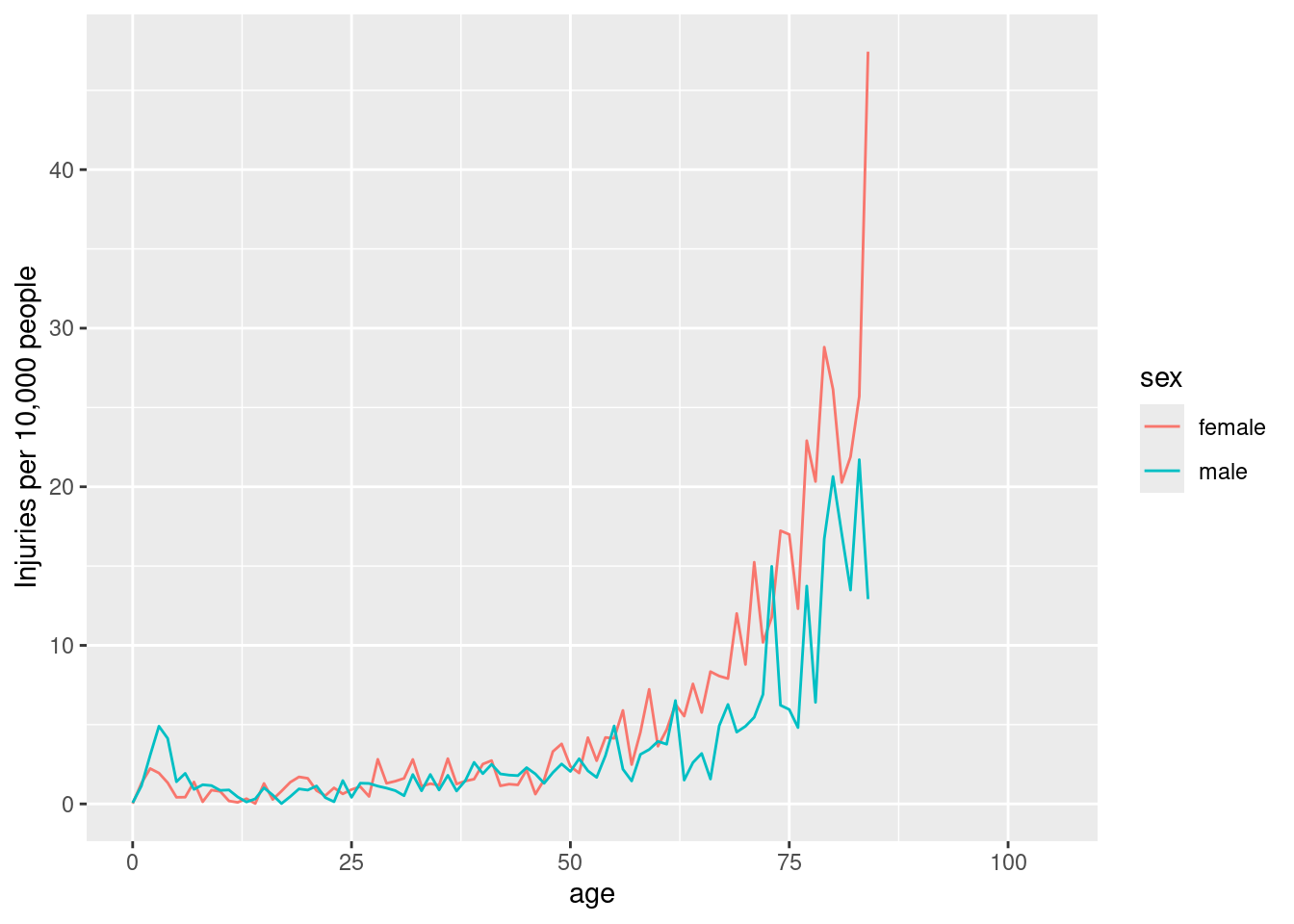4.3 Exploration
As motivation for the app we want to build, we’re going to explore the data.
Let’s have a look at accidents related to toilets:
# product code for toilets is 649
selected <- injuries %>% filter(prod_code == 649)
# nrow(selected): 2993We’re interested in how many accidents related to toilets we see for different locations, body parts and diagnosis.
## # A tibble: 6 × 2
## location n
## <chr> <dbl>
## 1 Home 99603.
## 2 Other Public Property 18663.
## 3 Unknown 16267.
## 4 School 659.
## 5 Street Or Highway 16.2
## 6 Sports Or Recreation Place 14.8## # A tibble: 24 × 2
## body_part n
## <chr> <dbl>
## 1 Head 31370.
## 2 Lower Trunk 26855.
## 3 Face 13016.
## 4 Upper Trunk 12508.
## 5 Knee 6968.
## 6 N.S./Unk 6741.
## 7 Lower Leg 5087.
## 8 Shoulder 3590.
## 9 All Of Body 3438.
## 10 Ankle 3315.
## # ℹ 14 more rows## # A tibble: 20 × 2
## diag n
## <chr> <dbl>
## 1 Other Or Not Stated 32897.
## 2 Contusion Or Abrasion 22493.
## 3 Inter Organ Injury 21525.
## 4 Fracture 21497.
## 5 Laceration 18734.
## 6 Strain, Sprain 7609.
## 7 Dislocation 2713.
## 8 Hematoma 2386.
## 9 Avulsion 1778.
## 10 Nerve Damage 1091.
## 11 Poisoning 928.
## 12 Concussion 822.
## 13 Dental Injury 199.
## 14 Hemorrhage 167.
## 15 Crushing 114.
## 16 Dermat Or Conj 84.2
## 17 Burns, Not Spec 67.2
## 18 Puncture 67.2
## 19 Burns, Thermal 34.0
## 20 Burns, Scald 17.0Weights?
- The NEISS data dictionary calls this column “Statistical Weight for National Estimates”
- perhaps a form of propensity weighting
Next we’ll we create a plot for the number of accidents for different age and sex:
summary <- selected %>%
count(age, sex, wt = weight) %>%
left_join(y = population, by = c("age", "sex")) %>%
mutate(rate = n / population * 1e4)
summary %>%
ggplot(mapping = aes(x = age, y = rate, color = sex)) +
geom_line(na.rm = TRUE) +
labs(y = "Injuries per 10,000 people")
4.3.1 Facet Wrap
Let us briefly look at all of the injury types in the data set.

Image code
injuries |>
group_by(prod_code) |>
count(age, sex, wt = weight) |>
left_join(y = population, by = c("age", "sex")) |>
mutate(rate = n / population * 1e4) |>
ggplot(mapping = aes(x = age, y = rate, color = sex)) +
geom_line(na.rm = TRUE) +
facet_wrap(vars(prod_code)) +
labs(title = "Accidents reported to emergency rooms in the US",
subtitle = "sample from 2013 to 2017",
caption = "Source: NEISS",
x = "Age",
y = "Injuries per 10,000 people")The goal is to build an app, which outputs the tables and the plot for different products, which the user selects.